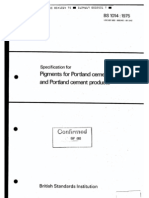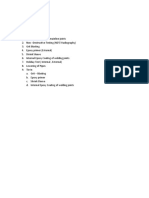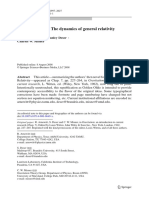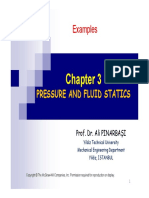0 ratings0% found this document useful (0 votes)
136 viewsSand Equivalent
Sand Equivalent
Uploaded by
Mrcoke SeieThis document provides the test method for determining the sand equivalent value of soils and fine aggregates. It describes:
1) The apparatus needed which includes a graduated plastic cylinder, mechanical shaker, calcium chloride solutions, and measuring tin.
2) The preparation of test specimens which involves splitting the material passing the No. 4 sieve to fill the 85mL measuring tin.
3) The test procedure which involves placing the specimen in the cylinder, adding calcium chloride solution, and shaking for a specified time to determine the sand equivalent value.
Copyright:
© All Rights Reserved
Available Formats
Download as PDF, TXT or read online from Scribd
Sand Equivalent
Sand Equivalent
Uploaded by
Mrcoke Seie0 ratings0% found this document useful (0 votes)
136 views11 pagesThis document provides the test method for determining the sand equivalent value of soils and fine aggregates. It describes:
1) The apparatus needed which includes a graduated plastic cylinder, mechanical shaker, calcium chloride solutions, and measuring tin.
2) The preparation of test specimens which involves splitting the material passing the No. 4 sieve to fill the 85mL measuring tin.
3) The test procedure which involves placing the specimen in the cylinder, adding calcium chloride solution, and shaking for a specified time to determine the sand equivalent value.
Original Description:
Sand Equivalent test
Copyright
© © All Rights Reserved
Available Formats
PDF, TXT or read online from Scribd
Share this document
Did you find this document useful?
Is this content inappropriate?
This document provides the test method for determining the sand equivalent value of soils and fine aggregates. It describes:
1) The apparatus needed which includes a graduated plastic cylinder, mechanical shaker, calcium chloride solutions, and measuring tin.
2) The preparation of test specimens which involves splitting the material passing the No. 4 sieve to fill the 85mL measuring tin.
3) The test procedure which involves placing the specimen in the cylinder, adding calcium chloride solution, and shaking for a specified time to determine the sand equivalent value.
Copyright:
© All Rights Reserved
Available Formats
Download as PDF, TXT or read online from Scribd
Download as pdf or txt
0 ratings0% found this document useful (0 votes)
136 views11 pagesSand Equivalent
Sand Equivalent
Uploaded by
Mrcoke SeieThis document provides the test method for determining the sand equivalent value of soils and fine aggregates. It describes:
1) The apparatus needed which includes a graduated plastic cylinder, mechanical shaker, calcium chloride solutions, and measuring tin.
2) The preparation of test specimens which involves splitting the material passing the No. 4 sieve to fill the 85mL measuring tin.
3) The test procedure which involves placing the specimen in the cylinder, adding calcium chloride solution, and shaking for a specified time to determine the sand equivalent value.
Copyright:
© All Rights Reserved
Available Formats
Download as PDF, TXT or read online from Scribd
Download as pdf or txt
You are on page 1of 11
At a glance
Powered by AI
The document describes the sand equivalent test method which provides a measure of the relative proportions of detrimental fine dust or clay-like material in soil or fine aggregates. It outlines the required equipment, materials, test procedure, and safety precautions.
The required equipment includes a sand equivalent test apparatus, mechanical or manual sand equivalent shaker, measuring tin, rubber stopper, funnel, oven, and timer.
The steps include obtaining a test sample, filling and capping the graduated plastic cylinder, attaching and operating the shaker, making measurements and calculations, and reporting results.
- 1 -
California Test 217
STATE OF CALIFORNIABUSINESS, TRANSPORTATION AND HOUSING AGENCY June 2008
DEPARTMENT OF TRANSPORTATION
DIVISION OF ENGINEERING SERVICES
Transportation Laboratory
5900 Folsom Boulevard
Sacramento, California 95819-4612
METHOD OF TEST FOR SAND EQUIVALENT
CAUTION: Prior to handling test materials, performing equipment setups, and/or conducting
this method, testers are required to read SAFETY AND HEALTH in Section I of
this method. It is the responsibility of the user of this method to consult and use
departmental safety and health practices and determine the applicability of
regulatory limitations before any testing is performed.
A. SCOPE
The sand equivalent test provides a
measure of the relative proportions of
detrimental fine dust or clay-like
material in soil or fine aggregates.
B. APPARATUS
The following equipment is required to
perform this test. Detailed descriptions
and specifications are included as
necessary to assure standardization.
Items bearing an Office of Purchasing
and Warehousing (OPW) catalog number
are available to California state agencies
from the Department of Transportation,
Office of Purchasing and Warehousing.
Detailed plans are available for these
items bearing a Transportation
Laboratory (TL) drawing number.
1. Sand Equivalent Test Apparatus
(Figure 1).
a. A graduated plastic cylinder,
rubber stopper, irrigator tube,
weighted foot assembly, and
siphon assembly, all conforming
to the specifications and
dimensions shown in TL drawing
number C 218 (Figure 3). A glass
or plastic container with cover,
having a minimum capacity of
one gallon, and fitted with the
siphon assembly or a discharge
tube near the bottom, shall be
used to dispense the working
calcium chloride solution. The
container shall be placed on a
shelf or suspended above the
work area in such a manner that
the level of the solution is
maintained between 36 and
46 inches above the work
surface.
2. Mechanical Sand Equivalent Shaker
(Figure 2).
a. A mechanical device designed to
hold a graduated plastic cylinder
in a horizontal position while
subjecting it to a reciprocating
motion parallel to its length.
The motion shall be provided
through a scotch-yoke
mechanism, which provides a
stroke length of 8 0.05 inches.
The device shall operate at a
speed of 175 2 complete cycles
per minute. Prior to use, the
shaker shall be fastened securely
to a firm and level mount.
b. TL drawing number D-256.
3. (Alternate) Manually-Operated Sand
Equivalent Shaker (Figure 4).
California Test 217
June 2008
- 2 -
a. A manually actuated device
designed to hold a graduated
plastic cylinder in a horizontal
position while subjecting it to a
reciprocating motion parallel to
its length. The device shall
consist of a carriage mounted on
top of two spring steel straps.
Motion shall be provided by
pushing the carriage in one
direction and allowing the spring
action of the straps to move it in
the opposite direction. The
shaker may be held stable by
hand, but it is recommended that
it be fastened securely to a firm
and level mount if a large
number of tests are to be run.
4. Measuring tin: A 3 oz. tin
approximately 2 inches in diameter
having a capacity of 85 5 mL.
5. Rubber stopper: A stopper to fit the
plastic cylinder.
6. Funnel: A wide-mouth funnel
suitable for directing the test
specimen into the plastic cylinder.
7. Oven: A drying oven set to operate at
230 9F.
8. Timer: A clock or watch reading in
minutes and seconds.
C. MATERIALS
1. Stock calcium chloride solution.
a. Sand Equivalent Stock Solution
OPW catalog number 6810-
0090-3.
b. May be prepared from the
following:
454 g (1 lb.) technical grade
anhydrous calcium chloride.
2050 g (1640 mL) USP glycerin
(95 %)
Dissolve the calcium chloride in
gallon of distilled or deionized
water. Cool the solution to room
temperature, then filter it
through Whatman No. 2V or
equivalent filter paper. Add the
glycerin to the filtered solution,
mix well, and dilute to 1 gallon
with distilled or deionized water.
2. Working calcium chloride solution.
a. Prepare the working calcium
chloride solution by diluting
85 5 mL of stock solution with
water to obtain 1 gallon of
solution. Thoroughly mix the
solution.
b. Working solution, which is more
than two weeks old, shall be
discarded.
c. The mixing and storage
container(s) shall be thoroughly
rinsed prior to mixing a fresh
batch of solution.
d. Fresh solution shall not be added
to old solution regardless of age.
3. Water.
Use distilled or deionized water for
the normal performance of this test,
including the preparation of the
working calcium chloride solution. If
it is determined, however, that the
local tap water is of such quality that
it does not affect the test results, it is
permissible to use it in lieu of
distilled or deionized water.
D. CONTROL
1. The temperature of the working
solution should be maintained at
72 5F during the performance of
this test. If this is impractical, it will
be necessary to establish
temperature correction factors for
each material being tested.
Establish correction factors by the
following procedures:
California Test 217
June 2008
- 3 -
a. Prepare a minimum of 12 test
specimens in accordance with
Section E of this test procedure.
b. Perform tests in groups of three,
using working solution at
different temperatures. Prepare
solutions near the upper and
lower expected temperature
range and at approximately 10F
increments through the range
should be used. The temperature
of the solution used with at least
one group must be 72 5F.
c. Establish a correction curve by
plotting the temperature of the
solution against the average test
value at that temperature.
d. This correction curve may be
used to determine the correction
that must be applied to obtain a
test value corrected to 72F.
e. Results for individual specimens
which meet the minimum sand
equivalent specification when the
temperature of the working
solution is below the
recommended range do not
require correction provided they
do not reduce the moving average
results below specified
minimums.
Example:
Test
Value
Temperature Range
of Solution
45F 55F 65F 75F
1 52 55 57 59
2 50 55 58 60
3 51 58 59 60
Average 51 56 58 60
A test performed on this material
when the temperature of the
solution was 50F would have to
be corrected by +6 points.
2. The workbench or table shall be a
flat level surface and shall be free of
vibrations.
E. PREPARATION OF TEST SPECIMENS
1. Prepare sand equivalent test
specimens from the passing No. 4
sieve portion of the material to be
tested after it has been processed
according to the procedures
prescribed in California Test 201,
except that reclaimed aggregate
containing traces of asphalt or
asphalt concrete shall not be oven
dried at temperatures greater than
100F.
a. Aggregates for use in Sacked
Concrete Slope Protection shall
be prepared as prescribed in
California Test 227. Since a
cleanness test is to be performed
on the coarse aggregate portion of
this material, do not remove the
fines from the material retained
on the No. 4 sieve.
2. Split or quarter the passing No. 4
sieve material to provide a test
specimen which fills the 85 mL
measuring tin to level full. The
accuracy of splitting or quartering
representative portions of a material
decreases as the sample size is
reduced. To minimize the effects of
adjusting the size of the relatively
California Test 217
June 2008
- 4 -
small sand equivalent test sample,
the following procedure should be
followed:
a. Determine the exact amount
required to provide four test
specimens by dipping four
measuring tins full of the
material and determining either
the combined volume or mass.
When filling the measuring tin,
tap the bottom edge of the tin
with a hard object or on a hard
surface to consolidate the
material. Fill each measure to
slightly rounded above the brim
and then strike off to level full
using a straightedge. After
determining the combined
amount, return the material to
the sample.
b. Carefully split or quarter the
predetermined amount of
material necessary to provide
four test specimens.
c. Split or quarter the premeasured
material to obtain a test
specimen. Two successive splits
will provide a specimen of the
proper size. Do not make
adjustments to the specimen size
by adding or removing material at
this time.
3. Dry the prepared test specimen to
constant mass at 230 9F and cool
to room temperature.
a. When testing reclaimed
aggregates containing traces of
asphalt or asphalt concrete, the
oven-drying temperature shall
not exceed 100F.
b. Aggregates, which are sampled
immediately after being dried in
an asphalt plant drier may be
tested without additional drying
provided they are not exposed to
dampness prior to testing.
Aggregates that are not tested on
the same day they are sampled
shall be oven-dried prior to
testing unless they have been
stored in moisture-proof
containers.
c. As a timesaving expedient in
routine work, it is permissible to
test materials in an air-dried
condition. Air-dried material,
which does not meet minimum
requirements, shall be retested in
an oven-dried condition and the
results of the oven-dried sample
will control.
F. TEST PROCEDURE
1. Read and record the temperature of
the working solution.
a. In a temperature-controlled work
area where the room temperature
remains constant within 5F
over a 24 hr period, the average
room temperature may be
recorded in lieu of the solution
temperature.
2. Fill the plastic cylinder to 4
0.1 inches with working calcium
chloride solution.
3. Pour the prepared test specimen into
the plastic cylinder (see Figure 5).
a. Use the funnel to avoid spillage.
b. Release air bubbles and promote
thorough wetting by bumping the
base of the cylinder against a
firm object while the test
specimen is being poured into the
cylinder or by tapping the
cylinder sharply on the heel of
the hand several times after the
test specimen has been poured
in.
c. Allow the wetted material to
stand undisturbed for 10 1 min.
4. Immediately following the 10 min
wetting period, agitate the test
specimen to break up clay lumps
and remove coatings.
California Test 217
June 2008
- 5 -
a. At the end of the 10 min soaking
period, stopper the cylinder, then
loosen the material from the
bottom by shaking the cylinder
while holding it in a partially
inverted position. Shake the
cylinder just enough to loosen
the material. Excessive agitation
may affect the test results.
b. Secure the cylinder in one of the
specified shakers and agitate
according to (1) or (2) below:
(1) Mechanical Shaker Method
(a) Set the timer and allow
the machine to operate for
45 1 s.
(2) Manual Shaker Method
(a) Set the stroke counter to
zero.
(b) Stand directly in front of
the shaker and place the
right hand against the
upper portion of the right
hand spring steel strap
(see Figure 6).
(c) Use the fingers and wrist
to apply enough force to
push the carriage to the
left until the pointer lines
up with the stroke limit
marker painted on the
backboard.
(d) Allow the spring action of
the straps to move the
carriage in the opposite
direction without
assistance or hindrance to
complete the cycle.
(e) Once the shaker is in
motion, maintain a
smooth oscillating motion
by gently applying
pressure to the right hand
strap during the thrust
portion of each cycle.
(f) The center of the stroke
limit marker is positioned
to provide the proper
stroke length and its
width indicates the
maximum allowable limits
of variation. Proper
shaking action is
accomplished only when
the tip of the pointer
reverses direction within
the marker limits.
(g) Continue the shaking
action for 100 strokes.
c. At the end of the shaking period
remove the cylinder from the
shaker, and set it upright on the
workbench.
5. Immediately irrigate the test
specimen with working calcium
chloride solution to flush the clay-
size particles from the sand.
a. Insert the irrigator tube in the
cylinder, start the flow of working
calcium chloride solution, and
rinse the material from the side
of the cylinder as the irrigator is
lowered.
b. With the cylinder remaining in an
upright position and the solution
flowing from the tip of the
irrigator, apply a twisting action
to the irrigator and force it to the
bottom of the cylinder (see
Figure 7). The flow of solution
will flush the clay-size particles
upward and into suspension.
Withdraw the irrigator from the
sample as necessary to change
position and again force it to the
bottom. The most effective
technique for penetrating the test
sample with the irrigator is to
hold the irrigator between the
palms of both hands and rotate it
by rubbing the hands back and
forth while applying a downward
pressure.
California Test 217
June 2008
- 6 -
c. Continue twisting and forcing the
irrigator to the bottom of the
cylinder until the fines have been
flushed from all areas of the
sample. Rotate the cylinder with
each penetration of the irrigator
and visually inspect the test
specimen for pockets of fine
material.
d. When the solution reaches the
15 inch mark in the cylinder,
slowly withdraw the irrigator
without shutting off the flow so
that the liquid level is maintained
at about 15 inches. Regulate the
flow just before the irrigator is
entirely withdrawn and adjust
the final level to 15 inches.
6. Immediately place the cylinder on a
workbench or table free of vibrations,
and allow the cylinder and contents
to stand undisturbed for 20 min
15 s from the time the irrigation is
completed.
7. Determine the clay reading.
a. At the end of the 20 min period,
read and record the level of the
top of the sediment column. This
is the clay reading (see Figure 8).
b. When the clay reading falls
between 0.1 inch graduations,
record the level of the higher
graduation.
c. If a clearly defined line of
demarcation does not form
between the sediment and the
liquid above it in the specified
20 min period, allow the cylinder
to stand undisturbed until the
clear line of demarcation does
form. Then immediately read and
record the time and height of the
column. If tap water was used,
retest an untested portion of the
sample using distilled or
deionized water.
d. If the liquid immediately above
the line of demarcation is still
darkly clouded at the end of
20 min, and the demarcation
line, although distinct, appears to
be in the sediment column itself,
read and record the level of this
line at the end of the specified
20 min period. If tap water was
used, retest an untested portion
of the sample using distilled or
deionized water.
8. Determine the sand reading.
a. After the clay reading has been
taken, gently lower the weighted
foot assembly into the cylinder
until it comes to rest on the sand.
Do not allow the sand reading
indicator to hit the mouth of the
cylinder as the assembly is being
lowered.
b. As the weighted foot assembly
comes to rest on the sand, tip the
assembly toward the graduation
on the cylinder so that the
position of the sand reading
indicator is visible. Take care not
to press down on the assembly.
c. Read the level of the top edge of
the indicator (see Figure 8).
d. Subtract 10 inches from the
observed reading. This is the
sand reading.
e. When the sand reading falls
between 0.1 inch graduations,
record the level of the higher
graduation.
G. CALCULATIONS AND REPORTING
1. Calculate the sand equivalent to the
nearest 0.1 using the following
formula:
SE = (Sand reading/Clay reading) x 100
2. If the calculated sand equivalent is
not a whole number, report it as the
next higher whole number.
California Test 217
June 2008
- 7 -
H. PRECAUTIONS
1. Perform the test in a location free of
vibrations, because vibrations may
cause the suspended material to
settle at a greater rate than normal.
2. Do not expose the plastic cylinders to
direct sunlight any more than is
necessary.
3. Occasionally a fungus growth may
develop in the working calcium
chloride solution. This fungus can
easily be seen as a slimy substance
in the solution or as a mold growing
on the inside of the container. When
this occurs, discard the remaining
solution, and clean the growth from
the container and from the inside of
the flexible tubing and irrigator by
the following procedure:
a. Prepare a cleaning solvent by
diluting sodium hypochlorite
(household bleach or equivalent)
with an equal quantity of water.
b. Fill the solution container with
the prepared cleaning solvent.
Allow about a liter of the cleaning
solvent to flow through the
siphon assembly, and irrigator
tube; then place the pinch clamp
on the end of the tubing to cut off
the flow of solvent and to hold the
solvent in the tube. Refill the
container, and allow it to stand
overnight.
c. After soaking, allow the cleaning
solvent to flow out through the
siphon assembly and irrigator
tube.
d. Remove the siphon assembly
from the solution container, and
rinse both with clear water. The
irrigator tube and siphon
assembly can be rinsed easily by
attaching a hose between the tip
of the irrigator tube and water
faucet and backwashing fresh
water through the tube.
4. At the beginning of each test, visually
observe the flow of solution from the
irrigator to ensure proper discharge.
If the solution is discharged from any
point other than the drilled holes,
immediately replace the irrigator. If
the drilled holes become clogged,
remove the obstruction by any
method that does not damage the
irrigator or change the size or shape
of the hole. Dislodging an
obstruction with a sharp object
should be done only as a last resort
and with extreme care.
I. SAFETY AND HEALTH
Soils and aggregates may contain
bacteria and/or organisms, which can be
harmful to one's health. The wearing of
dust masks and protective gloves when
handling materials is advised.
The use of heat resistant gloves/mitts or
potholders to remove samples from the
ovens is required.
When preparing stock solution,
protective eyewear, an approved
respirator, protective gloves, and apron
shall be worn.
The requirements listed for preparing
stock solution should be considered for
use when mixing working solution and
performing the Sand Equivalent test.
Prior to handling, testing or disposing of
any materials, testers are required to
read Caltrans Laboratory Safety Manual:
Part A, Section 5.0, Hazards and
Employee Exposure; Part B, Sections:
5.0, Safe Laboratory Practices; 6.0,
Chemical Procurement Distribution and
Storage; and 10.0, Personal Protective
Apparel and Equipment; and Part C,
Section 1.0; Safe Laboratory Practices.
Users of this method do so at their own
risk.
REFERENCES:
California Tests 201 and 227
End of Text
(California Test 217 contains 11 Pages)
California Test 217
June 2008
- 8 -
FIGURE 1
Sand Equivalent Test Apparatus
Excluding Shaker
FIGURE 2
Mechanical Sand Equivalent Shaker
California Test 217
June 2008
- 9 -
FIGURE 3
California Test 217
June 2008
- 10 -
FIGURE 4
Manually Operated Sand Equivalent Shaker
(Idaho Shaker)
FIGURE 5
California Test 217
June 2008
- 11 -
FIGURE 6
FIGURE 7
FIGURE 8
You might also like
- The Subtle Art of Not Giving a F*ck: A Counterintuitive Approach to Living a Good LifeFrom EverandThe Subtle Art of Not Giving a F*ck: A Counterintuitive Approach to Living a Good LifeRating: 4 out of 5 stars4/5 (5935)
- The Gifts of Imperfection: Let Go of Who You Think You're Supposed to Be and Embrace Who You AreFrom EverandThe Gifts of Imperfection: Let Go of Who You Think You're Supposed to Be and Embrace Who You AreRating: 4 out of 5 stars4/5 (1106)
- Never Split the Difference: Negotiating As If Your Life Depended On ItFrom EverandNever Split the Difference: Negotiating As If Your Life Depended On ItRating: 4.5 out of 5 stars4.5/5 (879)
- Grit: The Power of Passion and PerseveranceFrom EverandGrit: The Power of Passion and PerseveranceRating: 4 out of 5 stars4/5 (598)
- Hidden Figures: The American Dream and the Untold Story of the Black Women Mathematicians Who Helped Win the Space RaceFrom EverandHidden Figures: The American Dream and the Untold Story of the Black Women Mathematicians Who Helped Win the Space RaceRating: 4 out of 5 stars4/5 (925)
- Shoe Dog: A Memoir by the Creator of NikeFrom EverandShoe Dog: A Memoir by the Creator of NikeRating: 4.5 out of 5 stars4.5/5 (545)
- The Hard Thing About Hard Things: Building a Business When There Are No Easy AnswersFrom EverandThe Hard Thing About Hard Things: Building a Business When There Are No Easy AnswersRating: 4.5 out of 5 stars4.5/5 (353)
- Elon Musk: Tesla, SpaceX, and the Quest for a Fantastic FutureFrom EverandElon Musk: Tesla, SpaceX, and the Quest for a Fantastic FutureRating: 4.5 out of 5 stars4.5/5 (476)
- Her Body and Other Parties: StoriesFrom EverandHer Body and Other Parties: StoriesRating: 4 out of 5 stars4/5 (831)
- The Emperor of All Maladies: A Biography of CancerFrom EverandThe Emperor of All Maladies: A Biography of CancerRating: 4.5 out of 5 stars4.5/5 (274)
- The Little Book of Hygge: Danish Secrets to Happy LivingFrom EverandThe Little Book of Hygge: Danish Secrets to Happy LivingRating: 3.5 out of 5 stars3.5/5 (419)
- The World Is Flat 3.0: A Brief History of the Twenty-first CenturyFrom EverandThe World Is Flat 3.0: A Brief History of the Twenty-first CenturyRating: 3.5 out of 5 stars3.5/5 (2271)
- The Yellow House: A Memoir (2019 National Book Award Winner)From EverandThe Yellow House: A Memoir (2019 National Book Award Winner)Rating: 4 out of 5 stars4/5 (99)
- Devil in the Grove: Thurgood Marshall, the Groveland Boys, and the Dawn of a New AmericaFrom EverandDevil in the Grove: Thurgood Marshall, the Groveland Boys, and the Dawn of a New AmericaRating: 4.5 out of 5 stars4.5/5 (270)
- The Sympathizer: A Novel (Pulitzer Prize for Fiction)From EverandThe Sympathizer: A Novel (Pulitzer Prize for Fiction)Rating: 4.5 out of 5 stars4.5/5 (122)
- Team of Rivals: The Political Genius of Abraham LincolnFrom EverandTeam of Rivals: The Political Genius of Abraham LincolnRating: 4.5 out of 5 stars4.5/5 (235)
- A Heartbreaking Work Of Staggering Genius: A Memoir Based on a True StoryFrom EverandA Heartbreaking Work Of Staggering Genius: A Memoir Based on a True StoryRating: 3.5 out of 5 stars3.5/5 (232)
- On Fire: The (Burning) Case for a Green New DealFrom EverandOn Fire: The (Burning) Case for a Green New DealRating: 4 out of 5 stars4/5 (75)
- BS 1014-1975 Specification For Pigments For Portland Cement and Portland Cement ProductsDocument15 pagesBS 1014-1975 Specification For Pigments For Portland Cement and Portland Cement ProductsMrcoke SeieNo ratings yet
- The Unwinding: An Inner History of the New AmericaFrom EverandThe Unwinding: An Inner History of the New AmericaRating: 4 out of 5 stars4/5 (45)
- Waste Sector ProjectsDocument5 pagesWaste Sector ProjectsMrcoke SeieNo ratings yet
- Bagasse AshDocument6 pagesBagasse AshMrcoke SeieNo ratings yet
- Bagasse AshDocument6 pagesBagasse AshMrcoke SeieNo ratings yet
- Reinforced Concrete Beam DesignDocument8 pagesReinforced Concrete Beam DesignLindy Kho100% (1)
- Flexural StrengthDocument2 pagesFlexural StrengthMrcoke SeieNo ratings yet
- Damp Proof Membrane To PIFA Standard Datasheet 12-08-2011Document3 pagesDamp Proof Membrane To PIFA Standard Datasheet 12-08-2011Mrcoke SeieNo ratings yet
- MsDocument1 pageMsMrcoke SeieNo ratings yet
- Guidance Note 4-31-02 of The UK Water Research Centre.Document6 pagesGuidance Note 4-31-02 of The UK Water Research Centre.Mrcoke SeieNo ratings yet
- Jaguatirica Deviations PDFDocument24 pagesJaguatirica Deviations PDFAnonymous wCDPbgMLJNo ratings yet
- T210 Electrical Part List PDFDocument6 pagesT210 Electrical Part List PDFDaniel Cekul100% (1)
- 5Th Floor Plan 6Th Floor Plan: Part of KitchenDocument1 page5Th Floor Plan 6Th Floor Plan: Part of KitchenD.A.D.ANo ratings yet
- Gerry Tan Maintenance Technician - CVDocument4 pagesGerry Tan Maintenance Technician - CVGerry BaconNo ratings yet
- Quanta Zqta Zqsa SchematicsDocument44 pagesQuanta Zqta Zqsa SchematicsAbhilash VamanNo ratings yet
- Spare Parts Proposal Kit: Boyles C5CDocument6 pagesSpare Parts Proposal Kit: Boyles C5CRafael Castillo LimachiNo ratings yet
- STM32F429 DatasheetDocument226 pagesSTM32F429 DatasheetBhaskar SenNo ratings yet
- Chapter 8Document50 pagesChapter 8Amirul Izan100% (1)
- Zoom Valve DSP ManualDocument38 pagesZoom Valve DSP ManualRich ChardNo ratings yet
- Brought To You by Pro Gear & Transmission. For Parts or Service CallDocument3 pagesBrought To You by Pro Gear & Transmission. For Parts or Service CallOscar GonzálezNo ratings yet
- BWPX 307TGD-71 - Instruction Book - 2010Document218 pagesBWPX 307TGD-71 - Instruction Book - 2010Centrifugal SeparatorNo ratings yet
- Manual Equipo 1Document200 pagesManual Equipo 1Wakko20IPNNo ratings yet
- MC50 With Windows Mobile 5.0: User GuideDocument98 pagesMC50 With Windows Mobile 5.0: User Guideclaudiu1967No ratings yet
- Republication Of: The Dynamics of General Relativity: Richard Arnowitt Charles W. MisnerDocument31 pagesRepublication Of: The Dynamics of General Relativity: Richard Arnowitt Charles W. MisnerYanh VissuetNo ratings yet
- Examples 03Document213 pagesExamples 03Diego Alonso Huaraca BalerianoNo ratings yet
- Fundamentals of Statistical Physics: Leo P. Kadanoff University of Chicago, USADocument17 pagesFundamentals of Statistical Physics: Leo P. Kadanoff University of Chicago, USAOmegaUserNo ratings yet
- Log FileDocument4 pagesLog Filesanthoshkarthik123No ratings yet
- HG130 SM PDFDocument140 pagesHG130 SM PDFLucas Solon SolonNo ratings yet
- Catalog Dry DisconnectsDocument52 pagesCatalog Dry DisconnectsCristopher PatricioNo ratings yet
- ADE - The Future of MRODocument11 pagesADE - The Future of MROHarsleyNo ratings yet
- Sample 19544Document16 pagesSample 19544Sharad KumarNo ratings yet
- 121 Files 215 MB API RP 2A-LRFD-2019 NFPA 451-2020 PD CEN TR 17320:2019Document1 page121 Files 215 MB API RP 2A-LRFD-2019 NFPA 451-2020 PD CEN TR 17320:2019Mohamad ShafeyNo ratings yet
- 4th Quarter SCIENCE10 - Asynchronous Seatwork #3 (Charles' Law)Document2 pages4th Quarter SCIENCE10 - Asynchronous Seatwork #3 (Charles' Law)brylle legoNo ratings yet
- T2228 en Train The TrainerDocument14 pagesT2228 en Train The TrainerAvan SinghNo ratings yet
- Bill of Material: No Part Name Qty Dimension Material RemarkDocument1 pageBill of Material: No Part Name Qty Dimension Material RemarkFanir ZNo ratings yet
- Padeye CalcDocument3 pagesPadeye CalcFeryadi BuliNo ratings yet
- Crane Accidents in NYC 2013 To 2018Document29 pagesCrane Accidents in NYC 2013 To 2018Jan LeeNo ratings yet
- Rittal WM Stainless Steel Enclosures 5 3078Document8 pagesRittal WM Stainless Steel Enclosures 5 3078tzuvela99No ratings yet
- Using ALTERNATIVE in Smart FormsDocument2 pagesUsing ALTERNATIVE in Smart FormssaidaNo ratings yet
- DC Characteristics of A MOS Transistor (MOSFET) : Solved With COMSOL Multiphysics 4.4Document18 pagesDC Characteristics of A MOS Transistor (MOSFET) : Solved With COMSOL Multiphysics 4.4shree_rs81No ratings yet














































































